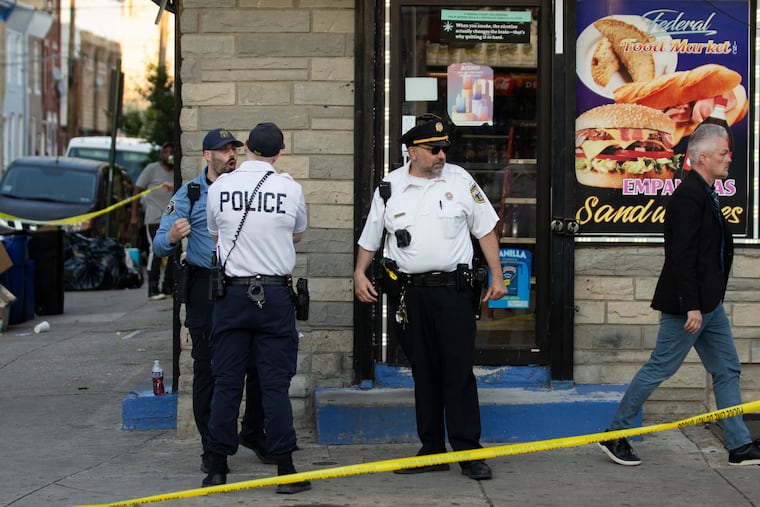Gun violence was more heavily concentrated in Kensington than almost anywhere else in the U.S. during the pandemic, NYT finds
There were 64 gun homicides within a quarter-mile of a block that’s just east of Kensington and Allegheny Avenues — a higher tally than any other block in the country, the New York Times said.

About three-quarters of Philadelphia residents lived within a quarter-mile of at least one fatal shooting that occurred between 2020 and 2023, and people who lived in Kensington — long the epicenter of the city’s gun violence crisis — experienced more concentrated violence than almost anywhere else in the country during that time, according to a New York Times analysis published Tuesday.
The newspaper mapped every gun homicide in the United States since 2020, finding that 47 million Americans — about one in seven — lived within a quarter-mile radius of a gun homicide over the last three years.
But the rates were far higher in Philadelphia, and especially in Kensington, the newspaper found. One stark example: There were 64 gun homicides within a quarter-mile of a block that’s just east of the intersection of Kensington and Allegheny Avenues — a higher tally than any other block in the country.
Bill McKinney, executive director of the New Kensington Community Development Corp., said he lives just a few hundred feet from that location, and called it “heavy” that his community might now carry that label. He believes the proliferation of gun violence in Kensington is a symptom of how the neighborhood has been deprived of a variety of public resources for decades.
“It speaks to the disparities that exist,” McKinney said. “I think it’s important to overlay similar studies that look at unemployment, poor education outcomes,” and similar structural issues, he added.
The Times said its analysis showed the “expanding footprint” of gun violence nationwide during the pandemic. Fatal shootings during that time frame continued to impact communities that have long been hard hit by violence, the newspaper said, where poverty levels are high and people of color are more likely to be victims. But homicides have also spread into new neighborhoods. During the pandemic, the Times reported, 23% more Americans lived on a block near a gun homicide than was the case four years earlier.
The findings underscore a reality that has been in sharp relief in Philadelphia in recent years, when the city’s annual levels of gun violence reached unprecedented heights. Numerous polls and surveys have shown that the overwhelming majority of residents view public safety as the top issue facing the city.
And The Inquirer was among many institutions that studied the issue, finding, among other things, that the rise in shootings disproportionately impacted communities where residents, mostly Black and brown, had long suffered not only from violence, but also endured higher poverty levels, lower life expectancy, and more blighted housing.
Mayor Cherelle L. Parker centered her campaign last year on a pledge to address crime, and since taking office in January, she has doubled-down on an enforcement-driven approach. In recent weeks, her administration has also begun attempting to disperse the sprawling open-air drug market in Kensington, which has long experienced the highest rates of gun crime in the city, although some activists and residents have criticized her reliance on police to address the Kensington situation, where many people are living on the street and suffering from addiction.
Across the country, the Times said, neighborhoods with high poverty levels and a higher share of residents of color correlated with higher exposures to violence. In Memphis, for example, 83% of people who lived in close proximity to violence were Black or Hispanic, the newspaper said.
And it said other jurisdictions were also struggling to combat both drug crime and homicides, quoting officials from Everett, Wash. — a city north of Seattle — as saying that a fentanyl epidemic has made it more challenging to address a rise in violence.
As for Philadelphia, the newspaper reported that the share of residents living near a homicide increased during the pandemic, from 65% in the four years before the pandemic to 75% between 2020 and 2023. And the percentage of people who lived near a homicide in both periods was significantly higher than in other cities, the newspaper found, something that likely reflects the reality that Philadelphia has one of the highest gun homicide rates in the country.
Buddy Osborn, a pastor and the founder of Rock Ministries on Kensington Avenue, said he wasn’t surprised by the finding about his neighborhood, but added: “I think we’re at a season and a time where ... we’ve got to put our best foot forward and basically turn this thing around.”
One trend that was not at the heart of the analysis: The city’s gun violence has been trending downward to begin 2024. As of Monday night, police statistics show, 95 people have been killed in homicides in the city this year, a 37% reduction compared with last year’s pace, and the lowest year-to-date figure since 2016. Non-fatal shootings are also down more than 40% compared with last year, the statistics show.